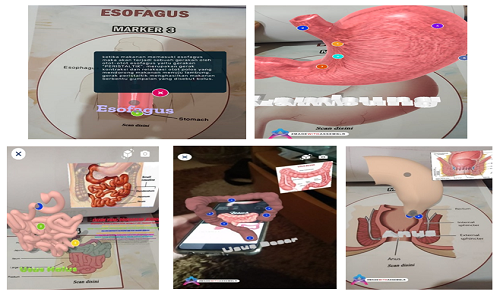
Development of Augmented Reality for Biology E-Magazine
Abstract
The purpose of this research is to design an electronic magazine design so that students are interested in participating in the learning process. Many students find it difficult to understand biology concepts because they cannot see it directly. We can use Augmented Reality technology in e-magazine design as one of these innovations. Therefore, this descriptive research was conducted to design an electronic magazine based on Augmented Reality. The development process was carried out in two stages, namely analysis and design. The analysis phase was carried out by observation using a questionnaire and the design phase was carried out by utilizing various computer software. The result of this research was an e-magazine design that is integrated with Augmented Reality, so that students can see abstract biological objects by 3D Augmented Reality directly with the technology. These results are expected to be developed and conduct further testing
Keywords
Full Text:
PDFReferences
Ade & Zulfarina. (2020). Design of Student Worksheets Based on Augmented Reality. Journal of Educational Sciences, 4(1), 176-186.
Andi, P. (2013). Panduan Kreatif Membuat Bahan Ajar Inovatif, Diva Press, Yogyakarta.
Bitter, G., & Corral, A. (2014). The pedagogical potential of augmented reality apps. International Journal of Engineering Science Invention, 3(10), 13-17. Arizona State University, USA.
Gafur, I. A., Yustina, Y., & Zulfarina, Z. (2020). Difficulties in the Material of Skeleton Systems and the Application of ICT in Learning Natural Sciences (IPA). Journal of Educational Sciences, 4(1), 187-199.
Harianti, D. (2008). Metode jitu meningkatkan daya ingat (memory power). Tangga Pustaka.
Iqbal M., Hengki & Helen. 2017. Pernerapan Augmented reality Sebagai media Pembelajaran virus dalam mata pelajaran biologi kelas X SMA. Jurnal sistem dan teknologi informasi (justin) Vol 5 No 2.
Juannita, J., & Adhi, B. P. (2017). Pengembangan Media Pembelajaran Sistem Pencernaan Manusia Untuk Kelas 8 SMP Dengan Fitur Augmented Reality Berbasis Android (Studi Kasus: SMPN 7 Depok). PINTER: Jurnal Pendidikan Teknik Informatika dan Komputer, 1(1), 76-81.
Nana Sudjana., 2005. Penilaian Hasil Proses Belajar Mengajar. Remaja Rosdakarya. Bandung.
Nurjanah, J. R., Sukarmin, S., & Rahardjo, D. T. (2014). Pengembangan Media Pembelajaran Interaktif E-Magazine Pada Materi Pokok Dinamika Rotasi untuk SMA Kelas XI. Jurnal Materi Dan Pembelajaran Fisika, 4(1).
Sangian, Novita. (2014). Rancang Bangun E-magazine Universitas Sam Ratulangi. Jurnal Teknik Informatika, 4(1).
Riduwan. 2007. Rumus dan Data dalam Aplikasi Statistika. Alfabeta. Bandung.
Sapuroh, S. (2010). Analisis kesulitan belajar siswa dalam memahami konsep biologi pada konsep monera di Man Serpong Tangerang. Jurusan Pendidikan IPA. Fakultas Ilmu Tarbiyah dan Keguruan. UIN Syarif Hidayatullah. Jakarta.
Sardiman, A. M. (2014). Interaksi dan Motivasi Belajar Mengajar, Rajawali, Jakarta.
Suryani, L. (2015). Improving students reading skills by using the mind map technique at SMAN1 Kretek in the academic year of 2013/2014. Yogyakarta: State University of Yogyakarta.
Widajanti, E. (2008). Peran Teknologi Informasi Untuk Mencapai Keunggulan Kompetitif. Fakultas Ekonomi Universitas Slamet Riyadi Surakarta.
DOI: http://dx.doi.org/10.31258/jes.5.3.p.511-519
Refbacks
- There are currently no refbacks.
Copyright (c) 2021 dekagusnia putri

This work is licensed under a Creative Commons Attribution 4.0 International License.
Publisher: FKIP Universitas Riau












